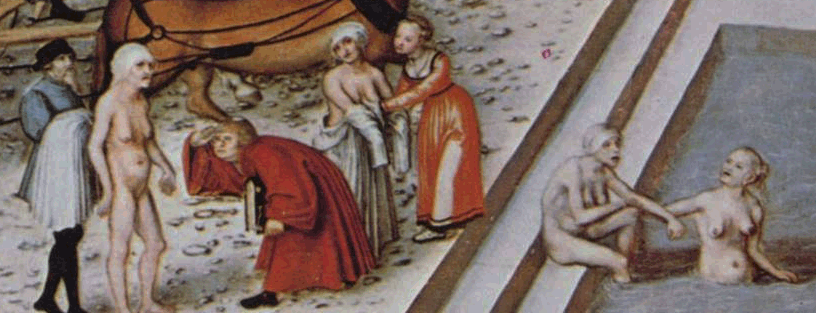When I was an impressionable teenager I recall reading a
very impressive editorial in the old Astounding Science Fiction, the predecessor
of this magazine. The editorial was written in the April 1949 issue by the then-editor, John W.
Campbell, Jr., and in it he speculated about the possibility that medical
science might find a cure for aging in his lifetime. Campbell suggested that
some near-future medical discovery might extend his life long enough to allow
him to make it to the next discovery and life extension, and so on, culminating
in a life span that was numbered in centuries rather than decades. Campbell, a
heavy smoker, actually died in late middle age of heart failure, a month after
celebrating his 61st birthday. Now, at an age somewhat greater than Campbell's
when he died, I share his desire for such a breakthrough. Fortunately for me, I
have learned from my friend Gary C. Hudson that an age-cure breakthrough may
actually be emerging from his new Seattle-based company, Oisin Biotechnologies (oisinbio.com).
In this column I want to discuss the Oisin approach to providing a cure for
aging.
Admittedly I'm an experimental physicist with a rather pedestrian knowledge and understanding of molecular biology, but I think I can nevertheless provide a clear account of this important development. First, to find an engineering fix to the problem of aging, we must understand just what aging is and what the underlying biological mechanisms behind it are. For example, why do the ages of our dogs and cats max out at about 18 years while some humans live to be over 100 and giant tortoises are still around at 150? What's going on at the cellular level that creates these differences between animal species?
A partial answer to this question is that the telomere sequences that form the ends of DNA chains get progressively shorter each time a cell division occurs. The telomere provides a docking region for the cell-replication bio-machinery, and each docking removes some of its length. Consequently, when the telomeres become too short, cell division cannot occur. Nature thus seems to have provided cells with a built-in count-down mechanism that limits the number of times that each cell can divide and reproduce. This was discussed in some detail in my AV column published in the February-1998 Analog.
However, the progressive shortening of telomeres in cell division is not the whole story of aging. There are active cellular mechanisms that can rebuild and lengthen telomeres, so telomere length decrease is not strictly a one-way street. Further, damaged body cells should not be encouraged to divide and reproduce, even if they are given longer telomeres.
It is now clear that one key element in understanding aging is the senescent cell. As the body ages, some cells become damaged and unable to fulfill their intended functions. This damage may be the result of short telomeres, transcription errors, ionizing radiation, oxidation, toxins, disease, and a long list of other causes. Such damaged cells become senescent, can no longer divide, cease their normal functions, and behave badly, secreting harmful chemical signals that degrade tissue function, generate inflammation, and interfere with the performance of nearby cells. In the body the effects of senescent cells show up in many ways, including "papery" skin cells, cataracts in eye lens cells, reduced recovery from exercise in muscle cells, arthritis in joint cells, organ degradation, a general tendency to form cancers, and so on.
In the geriatric medicine community there has been an ongoing debate centering on the question of whether the health of an aging animal would be improved by removing the senescent cells from its body. The group advocating active removal of senescent cells goes under the acronym of SENS, which stands for Strategies for Engineered Negligible Senescence.
One SENS technique for identifying senescent cells exploits a natural mechanism that senses their damaged condition and causes them to express a protein called "p16", which has the function of turning off the cell division machinery. (The p16 protein is also known to suppress tumor growth and is sometimes called a "tumor suppressor protein".) Support of the SENS position on aging has recently come from an experiment from the Mayo Clinic that was performed on transgenetic mice. Researchers rewrote a tiny portion of the mouse genetic code, providing the subject mice with cells that would produce a drug-triggered "suicide" protein whenever they began to express p16. This modification gave the researchers a drug-activated "kill-switch" that, when activated, would effectively scrub the bodies of middle-age mice clean of senescent cells. The result of this trial was that the subject mice, once their senescent cells had been removed, were conspicuously larger, more active, and healthier than a control group. In particular, the subject mice after treatment had their average life-spans increased by about 25% and showed a reduction in the incidence of cancer by about 50%.
This work inspired space entrepreneur Gary Hudson and computer scientist turned molecular biologist Matthew Scholz to join forces in founding Oisin Biotechnologies, a new Seattle-based company with the mission of developing a similar but more general approach to senescent cell clearance for humans and animals. The basic Oisin technique is to use standard DNA sequencing technology to sequence a special "plasmid". This plasmid is a small ring of DNA containing the coding for a p16-triggered promoter that controls the expression of an inducible suicide gene called "iCasp9". The iCasp9 gene produces a protein that initiates cell death, but that protein does not activate unless a small-molecule dimerizer is injected. The dimerizer causes the two halves of the iCasp9 protein to bind together, immediately triggering cell "apoptosis", i.e., the immediate disintegration and local cleanup of the target cell.

However, there is a delivery problem because the plasmid must be placed within the cell's surrounding membrane in order to operate. This problem is solved by placing the plasmid in the interior of a "fusogenic lipid nanoparticle" (LNP), a spherical "bubble" formed from a double-layer of waxy lipid molecules identical to those that form cell membranes. When a fusogenic LNP contacts a cell membrane, it fuses with it and delivers the enclosed material into the cell's interior.
When plasmid-loaded LNPs are injected into the subject's bloodstream, they are quite "democratic" and non-specific. They do not seek out cells with any specific functions or surface characteristics. Rather, they go everywhere that the bloodstream goes and deposit their genetic loads in all of the cells they encounter. After this LNP dispersal of the plasmids, a carefully controlled amount of dimerizer is injected into the bloodstream. The size of the dimerizer dose controls the number of senescent cells that will be cleared through apoptosis in this particular session.
The treated subject, having lost some fraction of its cell population, may require a period of replacement and recovery before the process can be repeated. There are, however, known procedures involving stem cell promotion that can enhance the cell-replacement phase of the process. It is expected that this procedure for senescent cell removal will be repeated until the subject is essentially clear of senescent cells.

This concept is very new, but all the trials so far have been very encouraging. Still, there are many questions that need to be answered. Once injected, how long do the plasmids remain active in cells? Over how many senescence-clearing sessions can the dimerizer be injected before the plasmids cease to function? Is there a limit to the number of senescent cells that can be eliminated in a single procedure without harming the patient? Can senescent brain cells be treated across the brain-blood barrier?
Some of these questions will be answered with planned tests on animals. There is a significant market for the life extension of pets and companion animals, particularly dogs and cats. There are plans for the establishment of Oisin Vet, a veterinary service that will apply the Oisin senescent cell clearance techniques described above to companion animals as a prelude to its application to humans.
I should also note that there has already been a significant spin-off from the Oisin anti-aging technique. One of the Oisin investors asked the company, in place of the p16 targeting for anti-aging, to explore the use of the technique to target tumors that are known to express the cancer-related protein p53. A p53-triggered plasmid was synthesized and a trial was performed on a strain of immunodeficient mice, chosen because the mouse immune system wouldn't reject the human PC3 prostate cancer cells that were implanted in their flanks. Surprisingly, the test showed as much as 90% reductions in tumor mass in 24-48 hours of treatment. These results were astonishing and virtually unprecedented. Human trials are now being planned in which the same treatment will be applied to males with late-stage prostate cancer.
Of course, this development raises many questions about the societal and science fiction implications of any cure for aging. What would an aging cure do to the population of the planet, the birth rate, the enthusiasm of some cultures for war, the retirement and Social Security systems, the life insurance industry, the stock market (where much retirement money is invested), the seniority system of the U. S. Congress, and the flow in our society of young people into the workforce as older people retire? Many SF writers, notably Robert Heinlein, Aldous Huxley, Damon Knight, Frederik Pohl, Poul Anderson, Iain M. Banks, and Bruce Sterling, have considered some of the implications of extended life spans or cures for human aging. However, I believe rich possibilities remain for new SF stories in this area, and they can better prepare us for the changes to come.
In conclusion, a potent treatment for aging is on the horizon. I believe that there is a good chance that it may be available for aging humans within the next decade. However, in closing, I want to point out a problem that may impede the needed progress. At present, the United States Food and Drug Administration (FDA) considers aging to be a natural process and explicitly does not recognize it as a condition warranting medical treatment. This erects barriers to funding research and development in the area of anti-aging. This must change if progress in age-treatment research is to be made at a reasonable rate. I request that those of you who read this and feel as I do about the importance of research on aging and its cure take action. I ask you to contact your senators and congressmen, particularly those serving on the Senate Committee on Health, Education, Labor, and Pensions and the House Committee on Energy and Commerce, and tell them that publicly authorized and funded research on treatments for aging through repair and regeneration is an important "public good", and that the FDA needs to accept aging as a legitimate condition for treatment.
Note: the two illustrations are details from Der Jungbrunnen (The Fountain of Youth) by the German painter Lucas Cranach the Elder (1472-1553).
John G. Cramer's 2016 nonfiction book (Amazon gives it 5 stars) describing his transactional interpretation of quantum mechanics, The Quantum Handshake - Entanglement, Nonlocality, and Transactions, (Springer, January-2016) is available online as a hardcover or eBook at: http://www.springer.com/gp/book/9783319246406 or https://www.amazon.com/dp/3319246402.
SF Novels by John Cramer: Printed editions of John's hard SF novels Twistor and Einstein's Bridge are available from Amazon at https://www.amazon.com/Twistor-John-Cramer/dp/048680450X and https://www.amazon.com/EINSTEINS-BRIDGE-H-John-Cramer/dp/0380975106. His new novel, Fermi's Question may be coming soon.
Alternate View Columns Online: Electronic reprints of 212 or more "The Alternate View" columns by John G. Cramer published in Analog between 1984 and the present are currently available online at: http://www.npl.washington.edu/av .
References:
Senescent Cell Clearance in Transgenetic Mice:
"Clearance of p16Ink4a-positive senescent cells delays ageing-associated disorders", Darren J. Baker, et al, Nature 479, 232-236 (10 November 2011); see also
"Ageing: Old cells under attack", Daniel S. Peeper, Nature 479, 186-187 (10 November 2011)
Oisin Biotechnologies web site:
Gary Hudson Interviews:
https://www.fightaging.org/archives/2016/02/an-interview-with-gary-hudson-of-oisin-biotechnologies-senescent-cell-clearance-startup/;
https://www.fightaging.org/archives/2017/06/an-update-on-the-work-of-oisin-biotechnologies-building-therapies-for-aging-cancer-and-other-conditions-by-targeting-harmful-cells-for-destruction/;
https://www.fightaging.org/archives/2017/07/leaf-interviews-gary-hudson-of-oisin-biotechnologies/.